Artículo
Communication during copulation in the sex-role reversed wolf spiderAllocosa brasiliensis: Female shakes for soliciting new ejaculations?
Fecha de publicación:
05/2015
Editorial:
Elsevier Science
Revista:
Behavioural Processes
ISSN:
0376-6357
Idioma:
Inglés
Tipo de recurso:
Artículo publicado
Clasificación temática:
Resumen
Traditional studies on sexual communication have focused on the exchange of signals during courtship.However, communication between the sexes can also occur during or after copulation. Allocosa brasilien-sis is a wolf spider that shows a reversal in typical sex roles and of the usual sexual size dimorphismexpected for spiders. Females are smaller than males and they are the roving sex that initiates courtship.Occasional previous observations suggested that females performed body shaking behaviors during cop-ulation. Our objective was to analyze if female body shaking is associated with male copulatory behaviorin A. brasiliensis, and determine if this female behavior has a communicatory function in this species. Forthat purpose, we performed fine-scaled analysis of fifteen copulations under laboratory conditions. Wevideo-recorded all the trials and looked for associations between female and male copulatory behaviors.The significant difference between the time before and after female shaking, in favor of the subsequentejaculation is analyzed. We discuss if shaking could be acting as a signal to accelerate and motivate palpalinsertion and ejaculation, and/or inhibiting male cannibalistic tendencies in this species.
Palabras clave:
Sexual Selection
,
Communication
,
Signal
,
Sex Roles
Archivos asociados
Licencia
Identificadores
Colecciones
Articulos(IDEA)
Articulos de INSTITUTO DE DIVERSIDAD Y ECOLOGIA ANIMAL
Articulos de INSTITUTO DE DIVERSIDAD Y ECOLOGIA ANIMAL
Citación
Garcia Diaz, Virginia; Aisenberg, Anita; Peretti, Alfredo Vicente; Communication during copulation in the sex-role reversed wolf spiderAllocosa brasiliensis: Female shakes for soliciting new ejaculations?; Elsevier Science; Behavioural Processes; 116; 5-2015; 62-68
Compartir
Altmétricas




